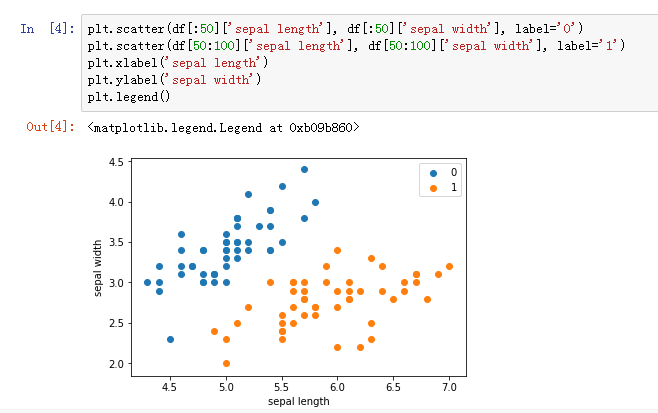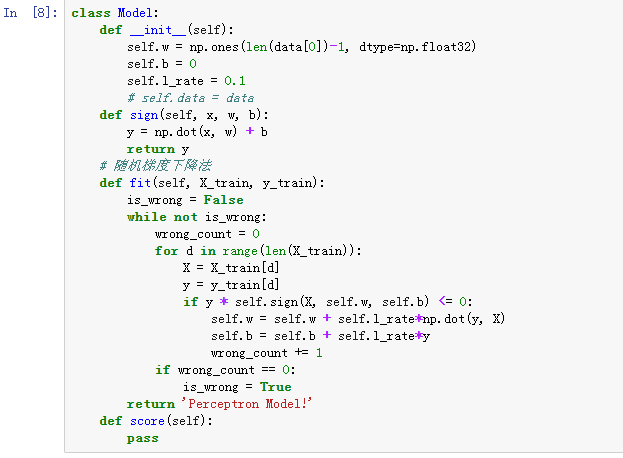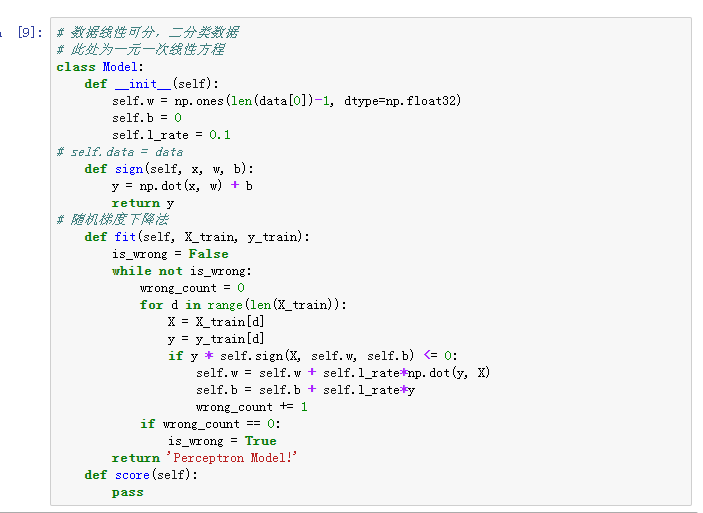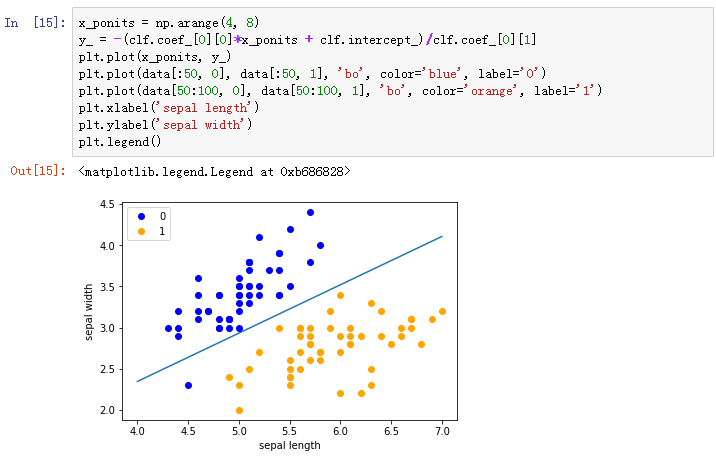实验一 感知器及其应用
一、作业信息
| 博客班级 | 机器学习实验-计算机18级 |
|---|---|
| 作业要求 | 实验一 |
| 学号 | 3180701232 |
二、实验目的
1.理解感知器算法原理,能实现感知器算法;
2.掌握机器学习算法的度量指标;
3.掌握最小二乘法进行参数估计基本原理;
4.针对特定应用场景及数据,能构建感知器模型并进行预测。
三、实验内容
1.安装Pycharm,注册学生版。
2.安装常见的机器学习库,如Scipy、Numpy、Pandas、Matplotlib,sklearn等。
3.编程实现感知器算法。
4.熟悉iris数据集,并能使用感知器算法对该数据集构建模型并应用。
四、实验过程及结果
实验代码及注释
1
import numpy as np
from sklearn.datasets import load_iris
import matplotlib.pyplot as plt
%matplotlib inline
2
iris = load_iris()
df = pd.DataFrame(iris.data, columns=iris.feature_names)将列名设置为特征
df['label'] = iris.target增加一列为类别标签
3
df.label.value_counts()value_counts确认数据出现的频率
4
plt.scatter(df[50:100]['sepal length'], df[50:100]['sepal width'], label='1')
plt.xlabel('sepal length')给图加上图例
plt.ylabel('sepal width')
plt.legend()
5
data = np.array(df.iloc[:100, [0, 1, -1]])
6
X, y = data[:,:-1], data[:,-1]X为sepal length,sepal width y为标签
7
y = np.array([1 if i == 1 else -1 for i in y])将两个类别设重新设置为+1 —1
8
%# 此处为一元一次线性方程
class Model:
def init(self):将参数w1,w2置为1 b置为0 学习率为0.1
self.w = np.ones(len(data[0])-1, dtype=np.float32) data[0]为第一行的数据len(data[0]=3)这里取两个w权重参数
self.b = 0
self.l_rate = 0.1
%# self.data = data
def sign(self, x, w, b):
y = np.dot(x, w) + b
return y
%# 随机梯度下降法
def fit(self, X_train, y_train):拟合训练数据求w和b
is_wrong = False判断是否误分类
while not is_wrong:
wrong_count = 0
for d in range(len(X_train)):取出样例,不断的迭代
X = X_train[d]
y = y_train[d]
if y * self.sign(X, self.w, self.b) <= 0:根据错误的样本点不断的更新和迭代w和b的值(根据相乘结果是否为负来判断是否出错,本题将0也归为错误)
self.w = self.w + self.l_ratenp.dot(y, X)
self.b = self.b + self.l_ratey
wrong_count += 1
if wrong_count == 0:直到误分类点为0 跳出循环
is_wrong = True
return 'Perceptron Model!'
def score(self):
pass
9
perceptron = Model()
perceptron.fit(X, y)感知机模型
10
x_points = np.linspace(4, 7,10)x轴的划分
y_ = -(perceptron.w[0]*x_points + perceptron.b)/perceptron.w[1]
plt.plot(x_points, y_)绘制模型图像(数据、颜色、图例等信息)
plt.plot(data[:50, 0], data[:50, 1], 'bo', color='blue', label='0')
plt.plot(data[50:100, 0], data[50:100, 1], 'bo', color='orange', label='1')
plt.xlabel('sepal length')
plt.ylabel('sepal width')
plt.legend()
11
from sklearn.linear_model import Perceptron定义感知机(下面将使用感知机)
12
clf.fit(X, y)使用训练数据拟合
13
print(clf.coef_)
14
print(clf.intercept_)
15
y_ = -(clf.coef_[0][0]*x_ponits + clf.intercept_)/clf.coef_[0][1]
plt.plot(x_ponits, y_)确定拟合的图像的具体信息(数据点,线,大小,粗细颜色等内容)
plt.plot(data[:50, 0], data[:50, 1], 'bo', color='blue', label='0')
plt.plot(data[50:100, 0], data[50:100, 1], 'bo', color='orange', label='1')
plt.xlabel('sepal length')
plt.ylabel('sepal width')
plt.legend()
五、运行截图
1

2

3

4

5

6

7

8

9

10

11

12

13

14

15

六 实验小结
通过这次实验,我理解了感知器算法原理,能实现感知器算法,掌握了机器学习算法的度量指标和最小二乘法进行参数估计基本原理,学会了针对特定应用场景及数据构建感知器模型并进行预测。


